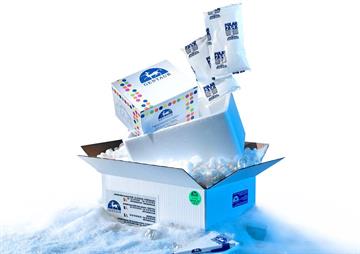MDM2 intrachain TR-FRET Assay Kit

MDM2 intrachain TR-FRET Assay Kit
2325 EUR
In Stock
quantity
Produktdetaljer
Katalognummer: 421 - 78302
Produktkategori: Företag och industri > Vetenskap och laboratorium
BPS BioscienceGentaur
Storlek: 384 rxns.
Related Products
79773
MDM2 TR-FRET Assay Kit
Human Casitas B-lineage lymphoma proto-oncogene b (MDM2) is an E3 ubiquitin-protein ligase that functions as a negative regulator of T-cell activation. It is a potential drug target in cancer immunotherapy. The MDM2 TR-FRET Assay Kit is designed to measure MDM2 auto-ubiquitination activity in a homogeneous 384 reaction format. It utilizes biotin-labeled ubiquitin and a terbium-labeled anti-GST antibody to complete the TR-FRET pairing. This FRET-based assay requires no time-consuming washing steps, making it especially suitable for high throughput screening applications.
1755 €
78301
Cereblon intrachain TR-FRET Assay Kit
Covalent conjugation to ubiquitin (Ub) is one of the major post-translational modifications that regulates protein stability, function, and localization. Ubiquitination is the concerted action of three enzymes: a Ub-activating enzyme (E1), a Ub-conjugating enzyme (E2), and a Ub ligase (E3). The specificity and efficiency of ubiquitination are largely determined by the E3 enzyme, which directs the last step of the Ub-conjugating cascade by binding to both an E2~Ub conjugate and a substrate protein. This step ensures the transfer of Ub from E2~Ub to the substrate, leading to its mono- or poly-ubiquitination.The Cereblon (CRBN) protein via its interaction with the DNA damage-binding protein-1 (DDB1), Cullin 4 (Cul4A or Cul4B), and regulator of Cullins 1 (RoC1) forms the functional E3 Ub ligase complex. In this complex, Cereblon functions as a substrate receptor that mediates the ubiquitination and subsequent proteasomal degradation of target proteins. Cereblon complex is involved in many biological processes including cell proliferation and apoptosis. That is why it has been employed for targeted protein degradation in the treatment of cancer. Like most E3 ligases, Cereblon complex ubiquitinates itself and this auto-ubiquitination promotes its Ub ligase activity.The Cereblon intrachain TR-FRET Assay Kit is a sensitive high-throughput screening (HTS) TR-FRET Assay Kit, designed to measure Cereblon auto-ubiquitination activity in a homogeneous 384 reaction format. It utilizes a Europium cryptate-labeled Ub (donor) as well as Cy5-labeled Ub (acceptor) to complete the TR-FRET pairing. Since both the TR-FRET donor and acceptor are incorporated into poly-ubiquitin chains formed on Cereblon, this FRET-based assay requires no time-consuming washing steps, making it especially suitable for HTS applications as well as real-time kinetics analyses of polyubiquitination.
2775 €
78303
SMURF1 intrachain TR-FRET Assay Kit
Covalent conjugation to ubiquitin (Ub) is one of the major post-translational modifications that regulates protein stability, function, and localization. Ubiquitination is the concerted action of three enzymes: a Ub-activating enzyme (E1), a Ub-conjugating enzyme (E2), and a Ub ligase (E3). The specificity and efficiency of ubiquitination are largely determined by the E3 enzyme, which directs the last step of the Ub-conjugating cascade by binding to both an E2~Ub conjugate and a substrate protein. This step ensures the transfer of Ub from E2~Ub to the substrate, leading to its mono- or poly-ubiquitination.The SMAD ubiquitination regulatory factor 1 (SMURF1) is a HECT-type E3 Ub ligase that regulates TGF-β/BMP pathways via ubiquitination of key signal transducers (SMAD1, SMAD2, or SMAD5), or TGF-β receptor I. SMURFs play a critical role in cell-type specification, tissue and organ development by regulating planar cell polarity signaling and convergent extension. SMURFs can also accelerate tumor progression, invasion, and metastasis as they regulate ubiquitination and subsequent proteasomal degradation of tumor-suppressing proteins including p53 as well as various cell signaling proteins. That is why SMURF1 and especially its Ub ligase activity is an attractive potential drug target in cancer immunotherapy. Like most E3 ligases, SMURF1 ubiquitinates itself.The SMURF1 intrachain TR-FRET Assay Kit is a sensitive high-throughput screening (HTS) TR-FRET Assay Kit, designed to measure SMURF1 auto-ubiquitination activity in a homogeneous 384 reaction format. It utilizes a Europium cryptate-labeled Ub (donor) as well as Cy5-labeled Ub (acceptor) to complete the TR-FRET pairing. Since both the TR-FRET donor and acceptor are incorporated into poly-ubiquitin chains formed on SMURF1, this FRET-based assay requires no time-consuming washing steps, making it especially suitable for HTS applications as well as real-time kinetics analyses of polyubiquitination.
2430 €
79101-2
RANK:RANKL TR-FRET Assay
The RANK:RANKL TR-FRET Assay is designed to measure the inhibition of RANK binding to RANKL in a homogeneous 384 reaction format. This FRET-based assay requires no time-consuming washing steps, making it especially suitable for high throughput screening applications. The assay procedure is straightforward and simple; a sample containing biotinylated RANK, RANKL, anti-His Tb donor, dye-labeled acceptor, and an inhibitor is incubated for two hours. Then, the fluorescence intensity is measured using a fluorescence reader.
1792.5 €
32618
ATAD2A TR-FRET Assay Kit
The ATAD2A TR-FRET Assay Kit is designed to measure the inhibition_x000D_of ATAD2A binding to its substrate in a homogeneous 384 reaction format. This FRETbased_x000D_assay requires no time-consuming washing steps, making it especially suitable for_x000D_high throughput screening applications. The assay procedure is straightforward and_x000D_simple; a sample containing terbium-labeled donor, dye-labeled acceptor, ATAD2A,_x000D_substrate, and an inhibitor is incubated for sixty minutes. Then, the fluorescence_x000D_intensity is measured using a fluorescence reader.
915 €
32619
CREBBP TR-FRET Assay Kit
The CREBBP TR-FRET Assay Kit is designed to measure the inhibition of CREBBP binding to its substrate in a homogeneous 384 reaction format. This FRET-based assay requires no time-consuming washing steps, making it especially suitable for high throughput screening applications. The assay procedure is straightforward and simple; a sample containing terbium-labeled donor, dye-labeled acceptor, CREBBP, substrate, and an inhibitor is incubated for sixty minutes. Then, the fluorescence intensity is measured using a fluorescence reader.
990 €
Håll dig uppdaterad! Visa tidigare publikationer

By: Author , 2 Comment
Anaplasmos hos hundar och katter – allt du behöver veta
23 August 2025

By: Author , 2 Comment
Solbränna – hur leker man säkert i solen?
16 August 2025

By: Author , 2 Comment
Biologiska läkemedel – Modernitet inom farmaci
1 August 2025

By: Author , 2 Comment
Icke-steroida antiinflammatoriska läkemedel – viktig information om populära läkemedel
22 July 2025








